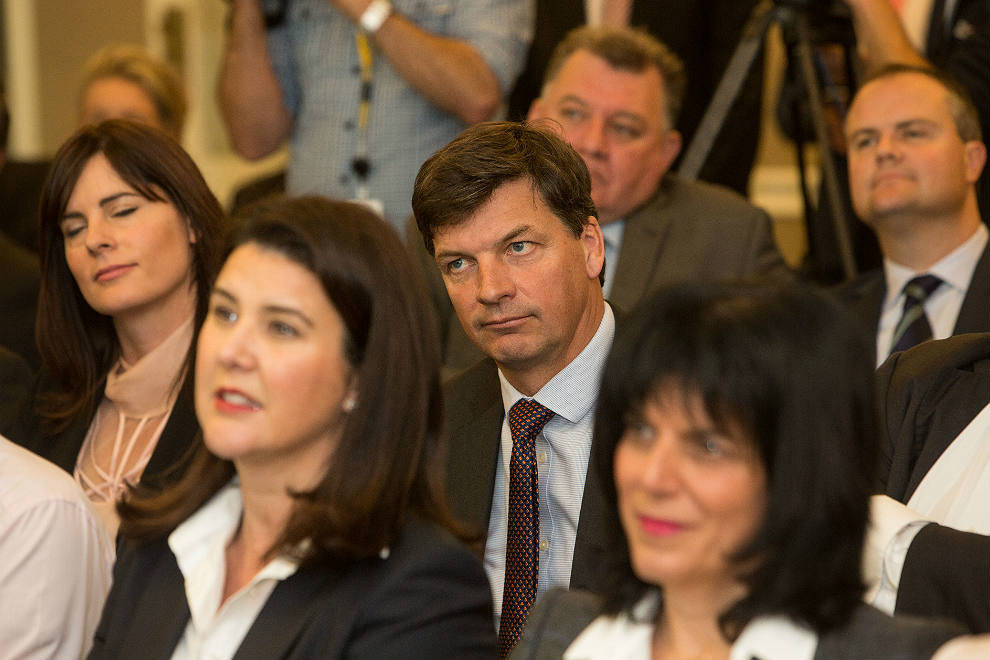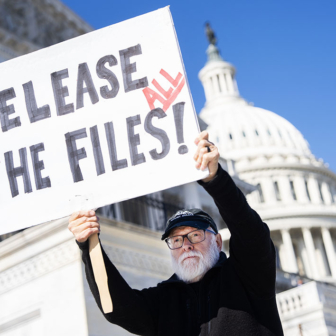George Orwell once cautioned that every time you hear the word “democracy,” substitute the word “fog” and the sentence will often make just as much sense. What he was saying was that the term is often quite meaningless or means something entirely different to what you might imagine. It can be put to multiple uses; it is a weasel word.
So, what are we to make of yet another call for the “democratisation” of candidate preselection processes in the NSW Liberal Party?
A prominent conservative federal MP, assistant cities and digital transformation minister Angus Taylor, has called for “reform” of the NSW party. Courageously defying party rules in a speech to the conservative Sydney Institute, he warned that the recent election result showed the Liberal Party was being outmatched by Labor’s ability to organise grassroots supporters. He blamed unnamed “powerbrokers” in the NSW branch who use arcane rules to amass voting blocs and exclude rank-and-file supporters from any meaningful involvement in the party.
The speech was courageous because it invited disciplinary action, although Taylor’s status as a frontbencher might confer immunity of sorts – unlike former Liberal MP Ross Cameron, whose party membership was suspended for making an identical point. The call was echoed the following day by former prime minister John Howard, and another disgruntled conservative, former party member John Ruddick, claimed that key figures in the overthrow of Tony Abbott in 2015 owed their cabinet positions to the current structure, singling out Malcolm Turnbull, defence minister Marise Payne and cabinet secretary Arthur Sinodinos.
The question is whether the Oxford-educated Taylor is really a champion of “democracy,” or something else. But some background is necessary before we investigate this question, for the Liberal Party’s NSW division is a very different creature from its fraternal divisions. Two anecdotes illustrate that difference.
In 1970, when prime minister John Gorton (from Victoria) was being ruthlessly undermined within the party, a recently elected Victorian Liberal, Neil Brown (later deputy leader of the party), visited London. There, he met a Liberal grandee, Sir Alexander Downer, then high commissioner to Britain, who was anxious for news of the developing crisis in Canberra. Taking Brown aside he whispered, “You must promise me one thing, Mr Brown. Never let the prime ministership fall into vulgar Sydney, commercial hands.”
Sir Alexander, a patrician South Australian, had served under Robert Menzies and was very familiar with the proclivities of the NSW party, especially those of the presumptive challenger, Billy McMahon, with whom he had served. (As it turned out, McMahon rolled Gorton three months later.)
The second anecdote relates to an internal party review of the NSW Liberals in the early 1980s, after yet another hiding at the polls by Labor under Neville Wran. The post-mortem, which looked at the party’s structure, policies and membership, called for a radical rethink to make branch membership both attractive and meaningful, and to give branch members a greater say in party matters.
A very senior Liberal had heard it all before, and wearily predicted he would hear it again in his lifetime. Shaking his head, he confided to a group of incredulous journalists, safely off the record, “Have you seen the sort of people who attend Liberal Party branch meetings? Well-meaning souls no doubt, but if they were ever entrusted to running the country, we would see capital punishment back tomorrow, military conscription and immediate war with one or more countries.”
In terms of political culture, New South Wales has long been different. Alone of the pre-Federation colonies, for example, it adhered to free trade as opposed to protection, creating the single biggest hurdle in the federation process. In a 1986 essay collection, The Sydney-Melbourne Book, political scientist James Jupp compared the political cultures of the two cities, noting that Melbourne was very much an “English city,” not because it was anything like England in reality “but because it preserved a social hierarchy which held political power as well as enjoying wealth and prestige…” In Sydney, by contrast, the congruence between wealth, power and prestige was “less perfect, partly because of the long dominance of Labor in local politics.”
Jupp observed that political conservatism in Sydney acquired the “ratbag characteristics of an outgroup” and spawned such things as the quasi-fascist New Guard in the 1930s and, later, strong groups of free marketeers and libertarians. Melbourne was quite different. “Melbourne conservatism remained quietly confident, because unthreatened,” Jupp wrote. “It was more genuinely liberal and less reactionary, a tradition still influential on internal Liberal Party politics today.”
It’s useful to add that in its early days the modern Liberal Party, founded by Menzies and others, was very much Victorian-dominated. NSW politicians and groups, which had fragmented into several warring cliques after the disintegration of the conservative United Australia Party in the 1940s, were lukewarm at best about coming on board. Even after they did, scepticism about Menzies notwithstanding, a group of NSW Liberals, including McMahon, were critical of the Menzies government’s two-airline policy and other aspects of the mixed economy and the broad Keynesian consensus. The Sydney group’s laissez-faire inclinations were very apparent.
After Eric Harrison, the leading NSW Liberal and deputy leader, was promoted upstairs by Menzies to become high commissioner in London, Victoria’s dominance was reasserted when Harold Holt was elected deputy. Holt succeeded Menzies in 1966, and Holt’s successor, Gorton, became PM in late 1967. The election of McMahon, close to media owner Frank Packer and other Sydney business interests, was the realisation of Downer’s fear. The risible tenure of this first Sydney-based leader was succeeded by that of a Victorian, Billy Snedden, who was later to remark that the Liberals would never again entrust the leadership to a Sydneysider.
Of course they did, after Malcolm Fraser and Andrew Peacock had led the party: twice to John Howard, once each to John Hewson, Brendan Nelson and Tony Abbott, and now, twice, to Malcolm Turnbull. The party, of course, has changed, and since Howard – very much a product of the NSW culture – a one-time aberration has become the Liberal norm.
Yet one of the paradoxes in NSW Liberal politics is that the enduring strain of conservative ideology has not been entirely dominant; the state has produced as many moderates as it has conservatives. In fact, the only electorally successful non-Labor premiers in the modern era, Bob Askin, Nick Greiner, Barry O’Farrell and Mike Baird, have all been moderates.
Fast forward now to 2016, with the leadership of the federal party having been firmly in NSW hands since 1995, and a Liberal state government in office. New South Wales is still not happy. Why?
Disagreements in 1944 over whether the new anti-Labor party was to be socially conservative (Sydney) or socially liberal (Melbourne) dated back to the early years of Federation, which saw George Reid (NSW) pitted against Alfred Deakin (Victoria) before they merged their forces, albeit uneasily, in 1909 in the “Fusion” to oppose Labor. Those tensions persist, and markedly so in New South Wales.
This is where the second anecdote comes in. Quite simply, the powerful organisational wing of the party has always looked askance at “reforms” (which were nearly always factional power grabs), and influential party heads such as Sir John Carrick and the late Jim Carlton were highly skilled at brokering truces between factions. A truce, by its very nature, is a fragile thing – a provisional cessation of open hostilities. Electoral success has always depended to a very large extent on upholding the truce; it was, for example, a crucial factor in bringing Nick Greiner to power in 1988.
The call by Angus Taylor for more “democratisation” is simply a partisan plea to abandon the truce. To throw open the preselection process exclusively to branch members, heavily skewed to the right, would be to effectively declare war on the minority moderates. It would be certain electoral suicide. The NSW state executive of the party, in insisting on a role in preselections, is being pragmatic more than ideological, recognising that to win marginal seats in New South Wales, at either state or federal level, the Liberals have to court traditional Labor voters, and right-wing populism might not be the most appropriate lure. The canny Askin, who was premier from 1965 to 1975, liked to characterise his policy approach as “10 per cent to the right of centre.”
People join political parties for a multitude of reasons, and there is no reason to assume they are in any way broadly representative of society as a whole. For a start, very few people join a political party at all. Australia has experienced a steady decline in membership of parties, with the Australian Bureau of Statistics putting total membership at just 1.3 per cent of the adult population in 2006 – the same percentage as in Britain, where there is growing concern about dramatic falls in member numbers, and much lower than in many European countries.
The decline has made parties secretive about membership numbers, making accurate figures difficult to come by. In Victoria, where the Liberal Party has traditionally been strong, an internal party review in 2008 revealed just 13,000 members in Australia’s second-most populous state, down from a peak in 1950 (in a much smaller population) of 46,000. More tellingly, the party’s median age stood at sixty-two against a median age of the population of forty-three.
Long ago, a certain philosopher expressed an ambivalence about democracy. According to Plato, unity is the desired end of both individual and state constitutions (and he might have added party, had they existed). He repeatedly asserted that the democratic “mob,” be it the mob of appetites in the human soul or the mob of citizens, must be controlled by a “rational element.”
In the NSW Liberal Party, the “undemocratic” state executive performs such a role. And the perception of unity it has managed to achieve has paid substantial electoral dividends. One must seriously question the political wisdom of taking up arms – even if in the name of democracy. It might well be that the executive has been saving the party from itself. •




